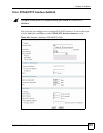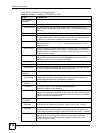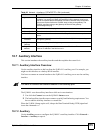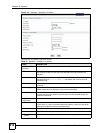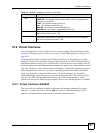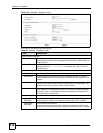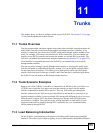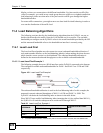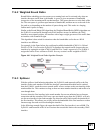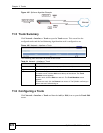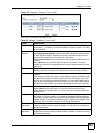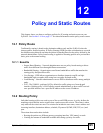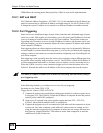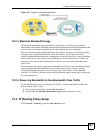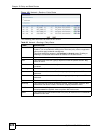
Chapter 11 Trunks
ZyWALL USG 1000 User’s Guide
221
11.4.2 Weighted Round Robin
Round Robin scheduling services queues on a rotating basis and is activated only when an
interface has more traffic than it can handle. A queue is given an amount of bandwidth
irrespective of the incoming traffic on that interface. This queue then moves to the back of the
list. The next queue is given an equal amount of bandwidth, and then moves to the end of the
list; and so on, depending on the number of queues being used. This works in a looping
fashion until a queue is empty.
Similar to the Round Robin (RR) algorithm, the Weighted Round Robin (WRR) algorithm sets
the ZyWALL to send traffic through each WAN interface in turn. In addition, the WAN
interfaces are assigned weights. An interface with a larger weight gets more of the traffic than
an interface with a smaller weight.
This algorithm is best suited for situations when the bandwidths set for the two WAN
interfaces are different.
For example, in the figure below, the configured available bandwidth of WAN1 is 1M and
WAN2 is 512K. You can set the ZyWALL to distribute the network traffic between the two
interfaces by setting the weight of WAN1 and WAN2 to 2 and 1 respectively. The ZyWALL
assigns the traffic of two sessions to WAN1 for every session's traffic assigned to WAN2.
Figure 144 Weighted Round Robin Algorithm Example
11.4.3 Spillover
With the spillover load balancing algorithm, the ZyWALL sends network traffic to the first
interface in the trunk member list until the interface’s maximum allowable load is reached,
then the ZyWALL sends the excess network traffic of new sessions to the next interface in the
trunk member list. This continues as long as there are more member interfaces and traffic to be
sent through them.
In cases where the first interface in the trunk member list uses an unlimited access Internet
connection and the secondary WAN uses a per-use timed access plan, the ZyWALL will only
use the next interface in the trunk member list when the traffic load exceeds the threshold on
the first interface. This allows you to fully utilize the bandwidth of the first interface to reduce
Internet usage fees and avoid overloading the interface.
In the following example figure, the upper threshold of the first interface is set to 800K. The
ZyWALL sends network traffic of new sessions that exceed this limit to the secondary WAN
interface.



